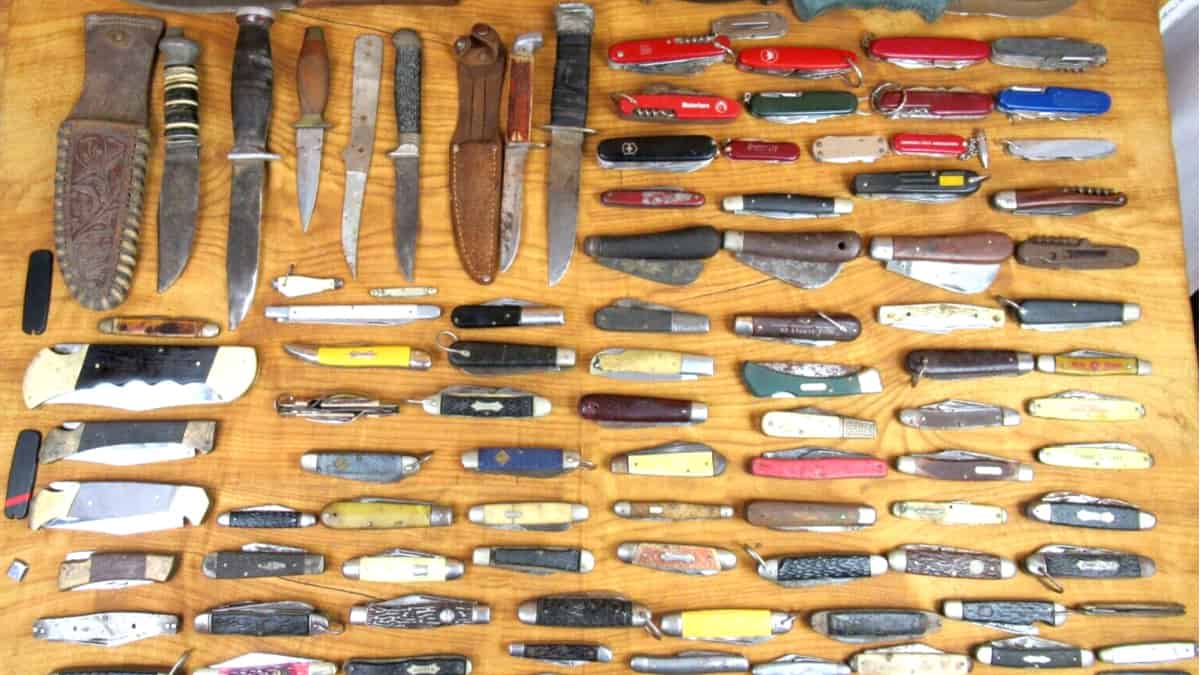As an Amazon Associate I earn from qualifying purchases.
There aren’t many things more exhilarating in the world of knife collecting than finding a high-quality knife from a brand you’ve never heard of.
This happened to me recently as I found a locked-up pocket knife in my 98-year-old grandpa’s basement. I was convinced that it was a 1930s Case XX with stag handles so I handled it with kid gloves and spent several days trying to treat the rust so I could open it and identify it to make sure.
Long story short, it wasn’t a Case. It also wasn’t valuable in any way and fell into rusted pieces upon opening. But that didn’t make it less exciting. At least not much.
In the world of antique collecting, all old pocket knives hold a unique allure. These vintage tools are more than just a blade and handle; they represent an era gone by, carrying with them stories of daily life, adventure, and craftsmanship.
Whether you’re a seasoned collector, a beginner in the field, or simply someone who found an intriguing old knife at a yard sale, the ability to identify old pocket knives accurately is a skill worth having.
In this article, we explore five ways to identify old pocket knives, from examining makers’ marks to engaging with knowledgeable communities online and in-store.
5 Tips For Identifying Vintage/Antique Knives
1. By Makers Marks
One of the most reliable ways to identify an old pocket knife is by looking for the maker’s mark. This mark is typically a name, logo, or symbol, often found on the blade, that indicates the manufacturer. In some cases, this mark might also be a model or style number, providing even more specific information about the knife.
Common marks to look out for include the ‘Buck’ anvil from Buck Knives, the ‘Case XX’ from W.R. Case & Sons, or the ‘Victorinox’ cross and shield from Swiss Army knives. If you discover a maker’s mark, research it online or in antique reference books to find more information about the brand and possibly the specific knife model.
2. By Scale Material
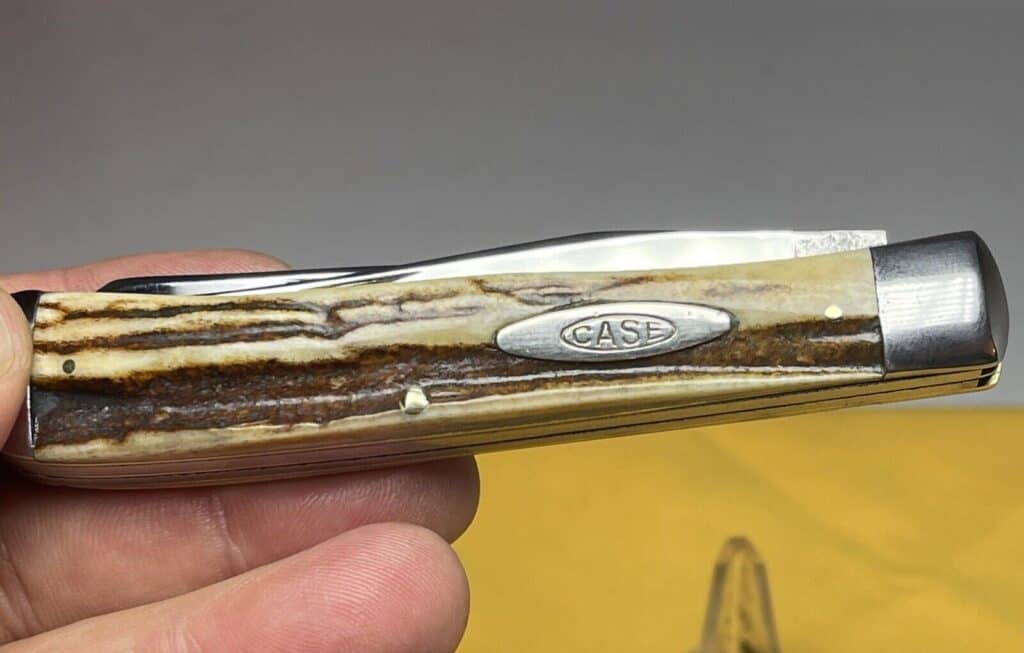
Another way to identify old pocket knives is by examining the scale material, which is the material used for the handle. Older knives were often made with natural materials like bone, wood, or mother-of-pearl, while more modern knives tend to use synthetic materials like plastic or G10.
For instance, if you find a knife with a stag or bone handle, it could be an older model, as these materials were common in the early to mid-20th century. The type of scale material can give you a rough estimate of the knife’s age and possibly its origin, but further research might be required for more accurate identification and aging.
3. By Knife Steel
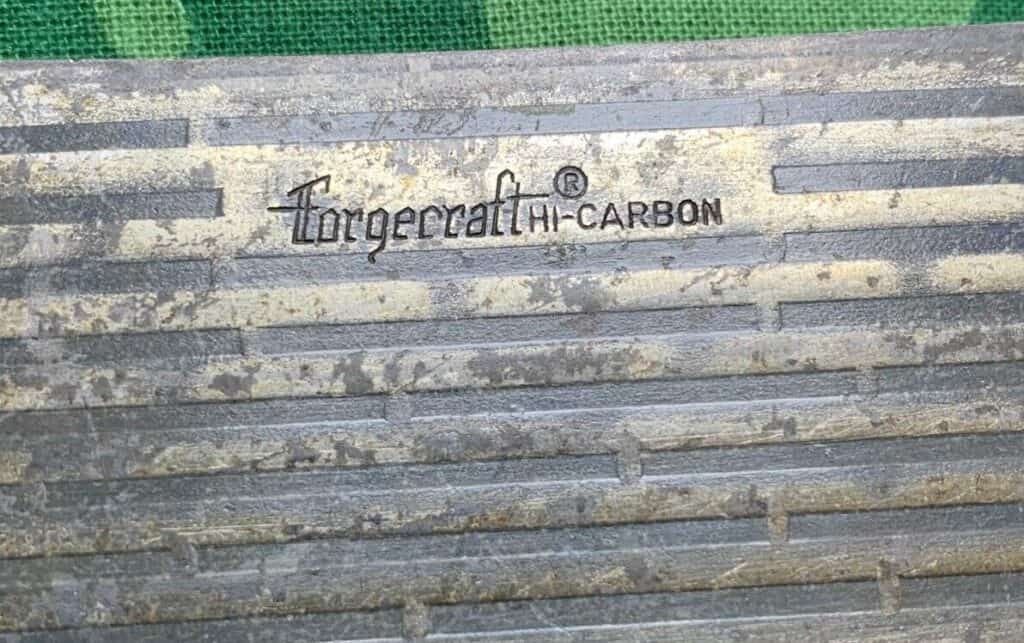
The type of steel used in the knife’s blade can also offer clues about its age. Early pocket knives were typically made from carbon steel, which is known for its ease of sharpening but prone to rust. Later, manufacturers began using stainless steel, which is more resistant to rust but generally harder to sharpen.
However, identifying the knife steel can be more challenging as it often requires some knowledge about different steel types. Carbon steel blades usually develop a patina over time, giving them a distinct aged look, while stainless steel blades tend to maintain a more polished appearance.
A good example here is the “Hi Carbon” blades from Forgecraft. While they used regular old high-carbon steel, they gave it a special-sounding name that was unique to their brand, making their knives easy to identify.
4. By Origin
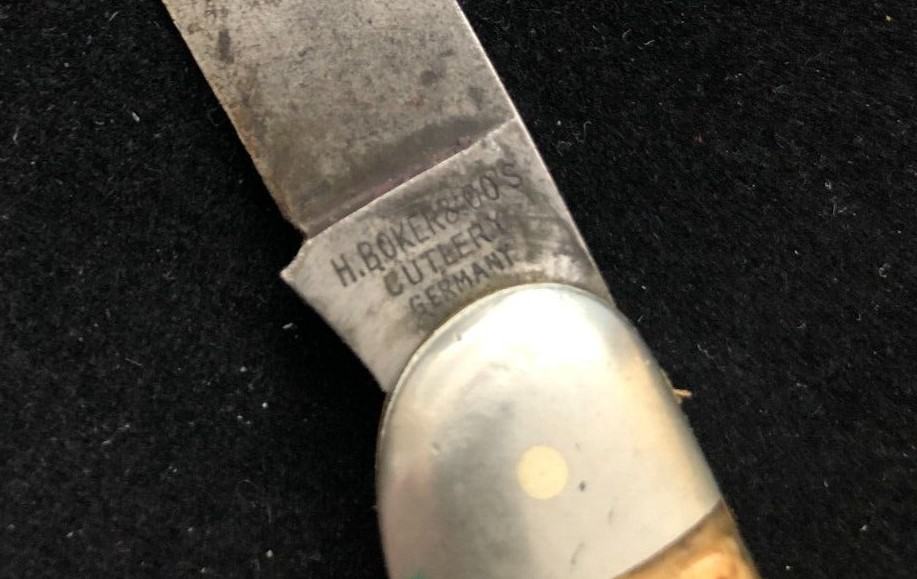
The country of origin can be a significant clue when trying to identify an old pocket knife.
Certain countries have strong histories in knife making, with characteristic styles and materials that can help identify the age and make of a knife. For example, a knife marked ‘Solingen’ might originate from the renowned blade-making city in Germany, while ‘Sheffield’ could denote a knife from the historic cutlery city in England.
The origin is often marked on the blade alongside the maker’s mark. While it isn’t always a sure-fire method, it can help you narrow your search if you have a maker’s mark and don’t even know where to start.
5. Post On A Forum/Visit A Shop
Finally, never underestimate the value of reaching out to others for help. The internet is a vast resource, home to countless communities of passionate collectors and experts who are often more than willing to lend their expertise. Online forums, like BladeForums or Reddit’s r/knifeclub, are fantastic platforms where you can post images of your pocket knife and ask for assistance in identifying it.
When posting, make sure to provide clear, well-lit photos of the knife from different angles, emphasizing any maker’s marks or unique features. A detailed description, including any physical characteristics and how you acquired the knife, can also be incredibly helpful.
Additionally, consider visiting a local antique shop or knife show. Interacting face-to-face with knowledgeable individuals can offer valuable insights, as they may be able to provide information that’s not readily available online. They could even identify a rare or valuable model that you weren’t aware of.
Remember, though, to take any information obtained from forums or shops with a grain of salt. I’ve visited many knife shops that were staffed with people with big heads and egos but very little knowledge of knives in general, especially vintage knives.
So consider this just another resource on your journey, but certainly not the only or even first line to take.
Pro Tip For Identifying Old Knives (Using eBay)
Well all else has failed, the best resource that I use for identifying old knives is good ol’ eBay.
By describing a knife, the maker’s marks, etc. I have found several knives that I wasn’t able to identify. As luck would have it, the person selling the knife often had more information about what they were selling than I was able to find.
Or, in one case, their knife was in better condition and they could actually read the maker’s name which I was unable to do.
If you’re in this level of desperation in trying to identify an old knife, here’s the method that I use:
1. Start Searching
Begin by entering what you know about the knife into the eBay search bar. This could include a description of the maker’s mark, the material of the handle, or the type of blade. I include terms like color, blade style, etc.
If the basic search doesn’t yield the desired results, make use of eBay’s advanced search options. Here, you can narrow down your search by category (like ‘Collectibles & Art’ then ‘Knives, Swords & Blades’), condition (used, not specified, or new), or even price and location.
2. Look at Completed Listings
One of the most beneficial features of eBay is the ability to view completed listings. This feature allows you to see items that have been sold in the past, along with their final selling prices. To access this feature, click on ‘Advanced’ next to the search bar, fill in your search criteria, and check the ‘Completed listings’ box before hitting search. This will give you a good idea of the value and rarity of similar knives.
In our case, what it really does it double the number of results you can see.
4. Analyze Item Descriptions and Photos
Once you’ve found a similar knife, analyze the seller’s description and photos. Many eBay sellers are collectors or experts themselves, and their descriptions can provide valuable information about the knife’s maker, age, and characteristics.
5. Reach Out to Sellers
Don’t hesitate to reach out to sellers for more information. Many sellers on eBay are knowledgeable about their items and are usually more than happy to share their knowledge. You can ask them questions about the knife’s origins, materials used, or any other details that might help you in identifying your vintage knife.
While many eBayers are resellers, I have talked to several who are selling a knife they got from their dad/grandpa/etc. and they could tell me more about where it likely came from and what era.
Now, if you’ve failed to figure out the answer on your own, with help, and with eBay, then here’s the last resort. Put the knife in your drawer.
I have several knives that I have not yet been able to identify but will be able to one day when the internet’s data set is more complete or a finally find a similar one on eBay.
Most Prolific Vintage Knife Makers (with pics)
It is super helpful (if you’re trying to identify a vintage knife) to realize that 90% of the surviving knives from yesteryear were made by only a handful of brands.
While the quality of the original knives is a huge reason for this, it is also because those who cared enough about knives to spend a bit more typically took better care of their knives and passed them down.
So, in all honesty, one of the following brands may very well be the one you’re looking for!
1. W.R. Case & Sons

W.R. Case & Sons, often just referred to as Case, is an American manufacturer known for its high-quality pocket knives. Vintage Case knives often have the stamp “Case XX” on the blade. The company used different tang stamps through the years which can help date a knife. The handle materials also varied, with bone, stag, and synthetic materials commonly used.
2. Buck Knives
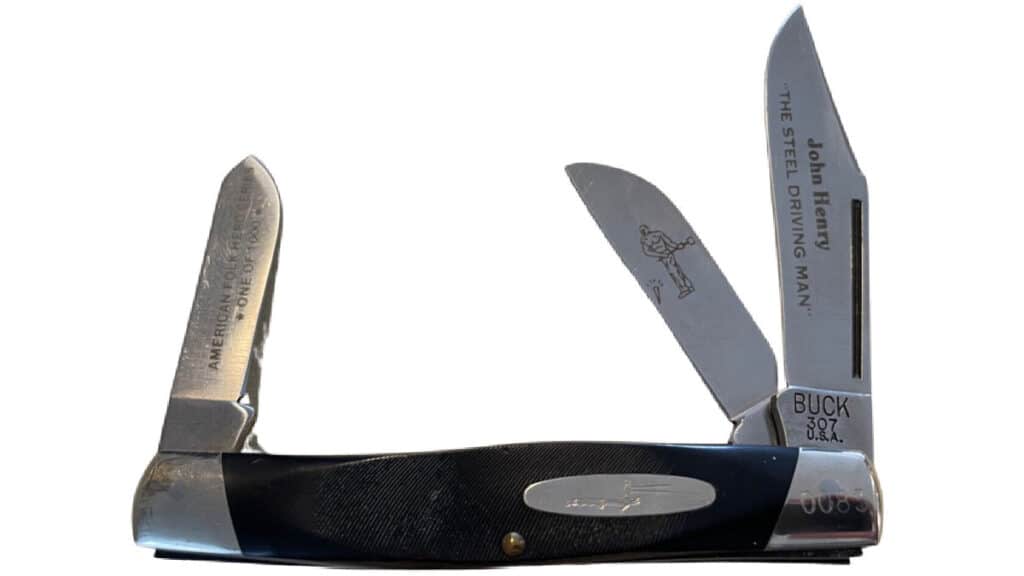
Buck Knives is another renowned American knife company. The most iconic Buck knife is the Model 110 Folding Hunter, introduced in 1964, featuring a distinctive lockback mechanism. Vintage Buck knives typically carry the ‘Buck’ name or symbol (an anvil) on the blade. The model number, such as ‘110,’ may also be stamped on the blade or the handle.
3. Victorinox
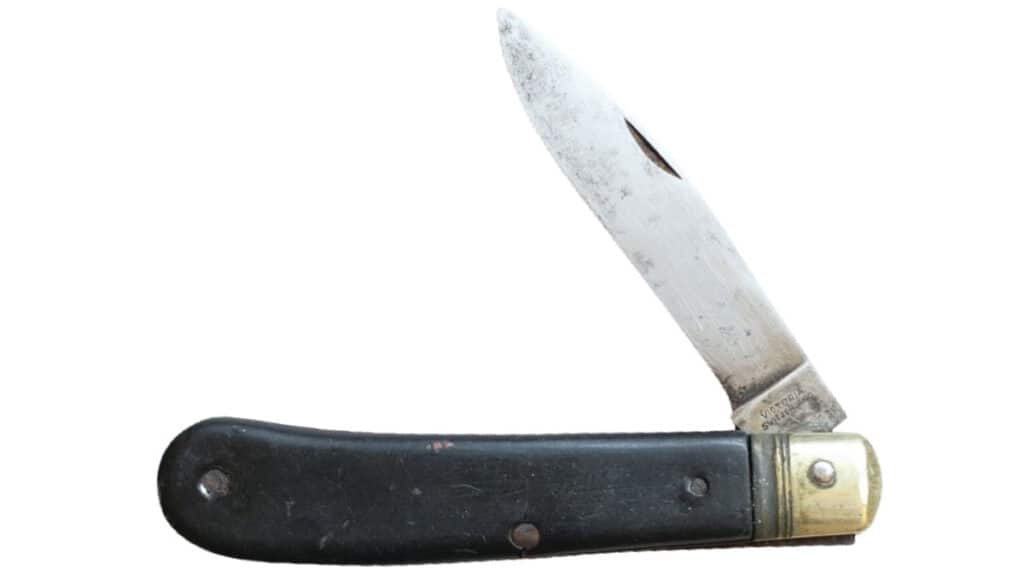
Victorinox, the Swiss company behind the original Swiss Army knife, has been producing knives since 1884. Victorinox knives usually have a distinctive shield and cross logo on the handle. Older models may have ‘Victoria’ (the founder’s mother’s name) stamped on the tang, while newer ones carry ‘Victorinox Swiss Made’ or similar variations.
4. Opinel
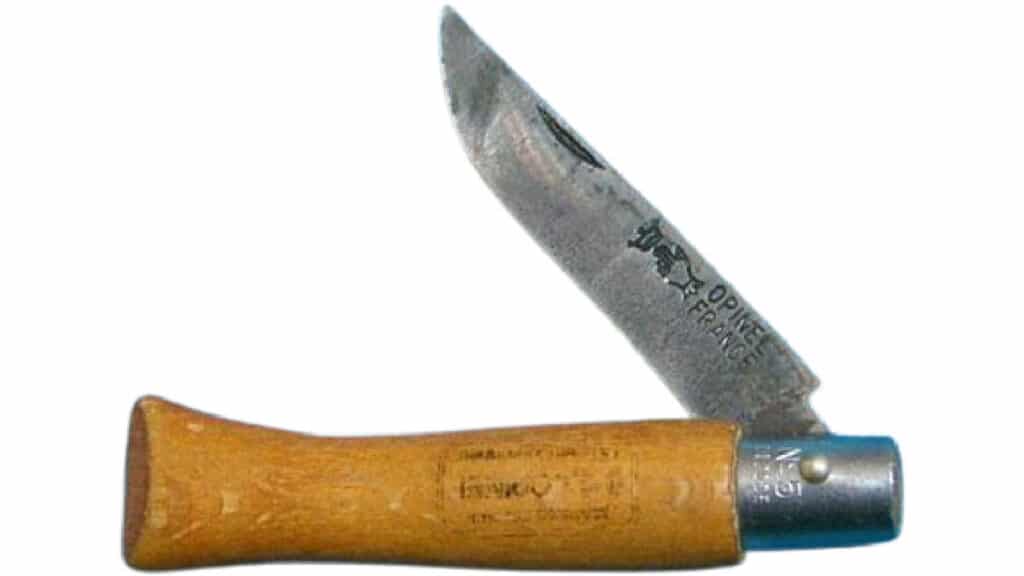
Opinel is a French company known for its simple, reliable, and affordable folding knives. Vintage Opinel knives usually feature a wooden handle and a high-carbon steel blade. They have a unique rotating collar lock system, and the company’s name is typically stamped on the blade. Some older models might also feature the phrase ‘Inox,’ indicating a stainless steel blade.
5. Imperial Schrade
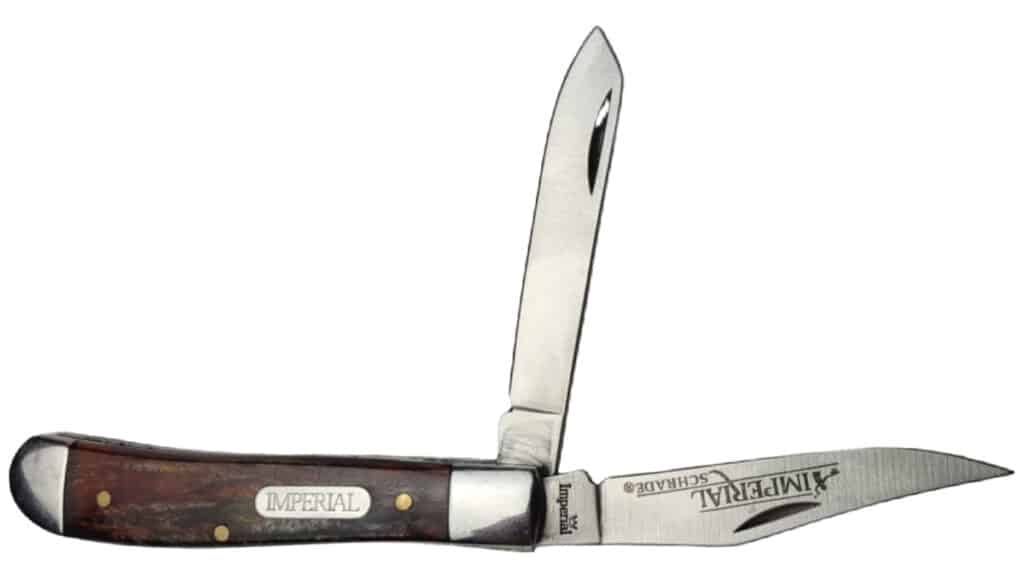
Imperial Schrade, an American knife manufacturer, was a prolific maker of budget-friendly pocket knives from 1904 until its closure in 2004. The company’s pocket knives often carry the ‘Imperial’ or ‘Schrade’ name on the tang. Their knives frequently featured plastic or celluloid handles, and many of their older models have a characteristic thin metal shield in the handle.
6. Puma
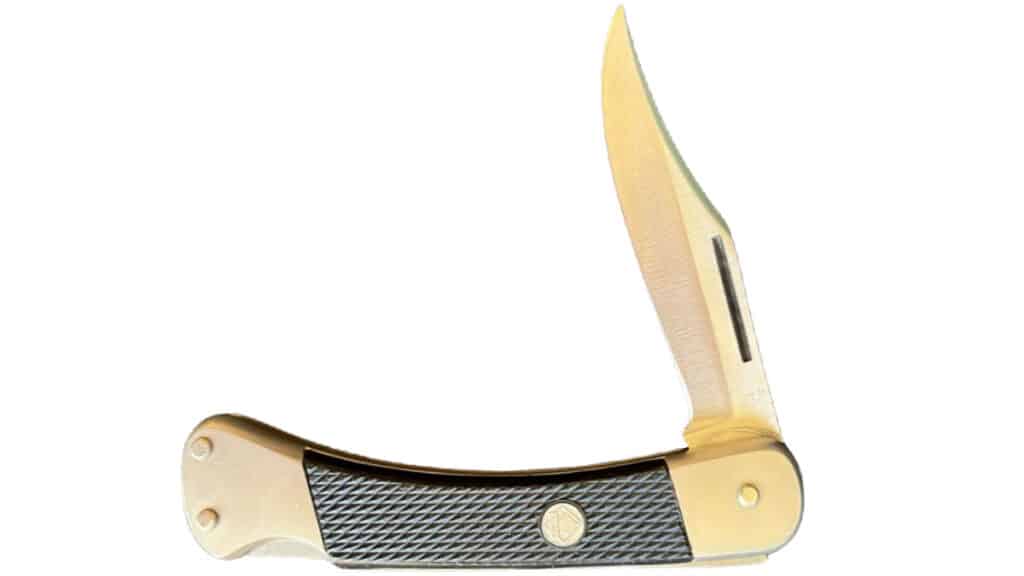
Puma, a German knife maker, has produced a wide range of hunting, sporting, and pocket knives since 1769. Puma knives are typically marked ‘Puma Solingen’ on the blade, signifying the city of their manufacture. Many of their vintage knives also have a unique number on the guard that can be used to determine the knife’s age.
7. Camillus
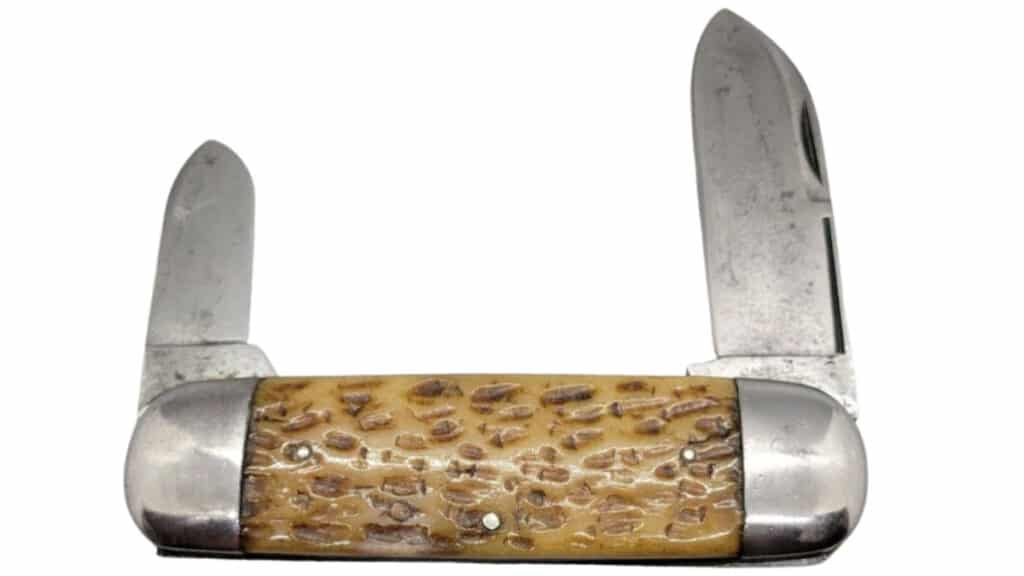
Camillus Cutlery Company was one of the oldest knife manufacturers in the United States with roots dating back to 1876. Vintage Camillus knives often bear the ‘Camillus New York’ tang stamp. The company was known for military knives, especially during World War II and the Vietnam War. They made various models, including the popular Camillus Scout knife, which often featured a black or brown handle and multiple blades.
Conclusion
When identifying vintage knives, recognizing the unique features of these prolific manufacturers can be a great starting point. Because knife manufacturing used to be such a laborious process there were relatively few models produced for each manufacturer so identifying a blade is usually not too hard.
Personally, I find identifying old pocket knives to be a thrilling journey, taking me through history and craftsmanship. It’s even better if I can come by the actual history of the individual knife I own.
As a last piece of advice, I’ll say, remember, patience and curiosity are key in this endeavor.
Happy collecting!
Do Sheepsfoot Blades Have A Purpose? (Cuz They’re Ugly…)
Spetsnaz Machetes – Blades Of The Russian Special Forces
What Is The Actual Purpose Of A Spear Point Knife Blade?
CRKT CEO Review – Coolest, Most Worthless Knife Ever?
How Sharp Is A Scalpel? (Is It Sharper Than A Razor?)
Can You Shave With A Knife? (Yes, Here’s How)
As an Amazon Associate I earn from qualifying purchases.

